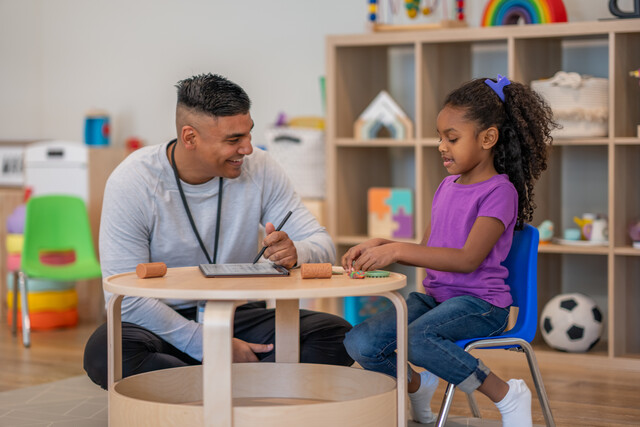Understanding Learning Disabilities?
Introduction
Learning disabilities are caused by a number of factors that result in millions of individuals - children and adults � experiencing difficulty in several areas of function within a learning environment. Understanding the characteristics and identification of learning disabilities, and their types and prevalence, helps parents, teachers and those diagnosed with a learning disability to overcome academic and social challenges.
As knowledge equates to power, information regarding the causes of learning disabilities, how they're commonly identified and treated, and how they are assessed and accommodated are important topics for millions. Many people confuse learning disabilities with learning problems, but they're not the same animal. A learning disability is defined as a noticeable learning difficulty in one or more specific academic areas. Learning disorders are based on clinical diagnoses, wherein an individual has met specific criteria in frequency, intensity, and degree of symptoms and issues.
In today's society, we often lump learning disabilities into one group, but there are actually more than half a dozen causes of learning disabilities that may affect an individual's ability to read or comprehend the written word, to perform mathematical or rational equations, as well as an inability to write correctly or legibly.
Practical approaches to instructional strategies will be briefly summarized for multiple age groups.
The most important thing for any individual diagnosed with a learning disability or learning disorder is to realize they are not alone. Some of the greatest and most powerful individuals in the world, from Albert Einstein, to Abraham Lincoln, experienced one or more types of learning disability.
Identification -- Signs of a Learning Disability
Learning disabilities are not always easy to identify. Because of differences in ages, behavior patterns, lifestyles, and upbringing, many children are not diagnosed with a learning disability for months, and even years. Following are common signs and characteristics that parents, teachers and professionals can utilize to narrow down the possibility of a learning disability.
Pre-K
- Slow growth of vocabulary
- Difficulty determining the right word to define an object or idea
- Slowed verbalization
- Difficulty learning the alphabet, colors, shapes, numbers or days of the week
- Difficulty following instructions
- Slowed fine motor skill development
- Often difficult interaction with those of the same age
- Difficulty with pronunciation (this is after determination of no physical factors or deformities that may affect speech, including varying degrees of deafness, cleft palate, etc.)
Kindergarten through Fourth Grade
- Difficulty remembering data or facts (history, spelling, math)
- Difficulty learning new skills (often, such individuals lean on memorizing)
- Consistent reversal or inversion of letters, such as d/b or m/w
- Routinely confuses or has difficulty writing or reading math signs
- Impulsive behavior
- Difficulty with reading analog or digital clocks
- Poor coordination
- Often accident prone
Fifth Grade through Eighth Grade
- Consistently reverses the sequence of letters
- Difficulty grasping the difference between root words, suffixes, and prefixes
- Resists reading out loud
- Difficulty with handwriting, often as a result of an awkward pencil grip
- Resists writing assignments
- Difficulty recalling facts
High school and Adulthood
- Continuous misspelling
- Continued avoidance of writing and reading assignments
- Difficulty rationalizing open ended questions
- Poor memory skills
- Difficulty grasping abstract concepts
- Resists new environments and settings
- Is either �ber-focused or disregards details
Characteristics
Keeping in mind that, again, learning types and behaviors differ among individuals, it may be eye-opening to view the data regarding learning disabilities among children and adults.
According to education.com, nearly 3 million school-age children in the United States today have been classified with specific learning disabilities and receive -- or have received -- special educational support. This breaks down to roughly 5 percent of school-age children in public school environments having been diagnosed with a learning disability. Of course, this percentage doesn't include those who are home-schooled, or who attend private or religious-based schools.
Learning disabilities do not focus on specific ethnic or racial groupings, but it does seem that boys are more often diagnosed with a learning disability than girls, at approximately a 3-to-1 ratio. In addition, between the ages of six and nine, the number of students who receive special education increases, while the most common age group (42 percent) are between 10 and 13 years of age. As children enter young adulthood between the ages of 16 and 21, a sharp decrease in research and statistics exists.
The Learning Disabilities Association of America provides information regarding adults with learning disabilities, stating that many girls who experienced a learning disability during their high school years were likely to drop out, many of them as a result of pregnancy (this data suggests that poor grades, low levels of confidence and self-esteem, lead many to simply give up).
The above statistics are not at all meant to imply that a learning disability equates with failure. Quite the contrary. Many famous individuals have overcome or learned to deal with and adapt to their learning disabilities, and have gone on to lead extremely productive and lucrative lives. The key toward dealing with, and sometimes even overcoming, a learning disability depends on the type of learning disability one faces.
Introduction
When most people think about learning disabilities, they think about dyslexia, which is one of the most common; but there are many different types of learning disabilities, as well as their prevalence in various age groups. In this article, we'll discuss the most common types of learning disabilities, break them down into prevalence of age groups, from toddlers to adults, and then offer a brief summary of the most commonly identified and treated learning disabilities.
Breaking Down Learning Disabilities
Learning disabilities are experienced by children and adults due to numerous issues, most of which center in the brain. In the United States, nearly 5 million individuals have been diagnosed with a learning disability, and among those, more than 4.5 million are children. According to the National Institutes of Mental Health, 1 in 59 individuals in the United States is diagnosed with a learning disability.
The most common learning disabilities include, but are not limited to:
Communication disorders - This type of learning disability impairs a person's ability to communicate. Communication issues may involve faculties with language, speech, hearing, and overall development. Some of the most common types of communication disorders include autism, stuttering, and dyslexia. Some examples of communication disorders also include:
-
- Developmental articulation disorder
- Developmental expressive language disorder
- Developmental receptive language disorder
- Mixed receptive expressive language disorder
- Phonological disorders
- Stuttering
Other types of learning disabilities are broken down into the topic or area of difficulty, including:
Developmental reading disorders
Developmental writing disorders
Developmental arithmetic disorders
In essence, a learning disability should never be classified as a specific disorder, but a category of disabilities that can reach into seven different arenas:
- Expressive language, or speaking
- Receptive language, or listening
- Written expression
- Basic reading skills
- Reading comprehension
- Mathematical reasoning
- Mathematics calculation
There exists a greater prevalence of reading disorders than mathematical disorders, but many overlap. For example, a child with a reading comprehension disability may also have difficulty with calculating and reasoning when it comes to math.
In some cases, demographics do have an impact on learning processes, and children born into poverty or such scenarios often have more difficulties with learning, mainly due to economic disadvantages, lack of parental help in regard to school work, and lack of social support. In addition, increased classroom sizes, a decrease in student-to-teacher ratios, and other factors may also contribute to a number of learning disabilities.
Other learning disabilities involve disorders with motor skills, or attention disorders such as ADHD. Other disorders are classified not only as a cause, but as a diagnosis, such as dyslexia, dysnomia, and other types of concentration disorders.
Without attempting to minimize the issue of learning disabilities, it must be recognized that some children learn at a slower pace than others, or pay less attention due to their very nature, and not because of a learning disability. In today's more sedentary environment, reduced physical education and playground or recess time, children should be expected to grow antsy, bored, and frustrated with extended classroom time and scenarios.
This by no means implies that millions of children and adults do not have a learning disability, but merely to emphasize that many children, in the past and today, have been diagnosed or labeled with a learning disability - in error.
Many common causes of learning disabilities are definitely brain-oriented and have a very severe effect and impact on a child's ability to read, write, and complete mathematical equations. It should be noted that the prevalence of learning disabilities and their identification has increased by leaps and bounds in the past two decades, though many continue to dispute the objective criteria used in diagnosing or labeling someone with a learning disability.
Concurrent Learning Disabilities
While it is recognized today that roughly 5 percent of school children have been identified with a learning disability, learning disabilities often overlap. For example, several of the types of learning disabilities, such as those listed above, can occur in conjunction with another type of learning disability, or deficits in social skills, and can be coupled with behavior or emotional disorders.
For example, one type of disability, phonological awareness, is closely related to a person's ability to read, and it's often recognized as early as kindergarten or the first grade. It's often difficult to classify a child as having a mild reading disability, and is more common to recognize one with an extreme reading disability, although many children are slower to grasp the foundations of language and reading, and catch up in later grades. However, it is known that the longer a child who struggles with a basic skill, at any level, grade, or severity, may have more difficulty overcoming that disability in later years.
Coupled with a severe learning disability, children often express or exhibit a number of behavioral and social "deficits." Such behaviors and attitudes in social environments may stem from frustration, feelings of inadequacy, or embarrassment, making it difficult to intervene and help such children.
It's extremely important for teachers as well as parents and social groups, to recognize that even a mild deficit in reading, writing, and arithmetic can exacerbate learning difficulties in other areas, as the child grows. It's very important to identify and intervene in such situations as soon as possible, which requires patience, knowledge, guidance, and understanding.
Most Commonly Identified and Treated Learning Disorders
In children, the most commonly identified and treated learning disability disorders focus on reading disabilities, classified as dyslexia. Two major types of learning disabilities are identified in reading:
- Difficulty with reading comprehension in regard to grasping the meaning of sentences and paragraphs
- Difficulty understanding the coexistence and relationship between words, letters, and sounds
Auditory and visual processing problems are also commonly identified and classified as an auditory processing disorder, where an individual hears the words, but experiences an inability to distinguish differences in sound, making it difficult for the person to not only sound out words, but understand their foundation and importance in writing and reading.
A visual processing disorder, such as dyslexia, causes words, letters, and sentences to appear differently to the individual than what is actually written. For example, trouble with depth perception and hand-eye coordination are common with those diagnosed with a visual processing disorder, as is skipping over words, reversing letters or numbers, as well as an inability to differentiate between subtle shape differences.
Autism is a developmental disorder that causes an individual to have difficulty with communication, basic skills learning, social development, and understanding. In its earliest forms, and during the pre-K years, it's often difficult for parents, or even experts, to differentiate between a mere slow learner, a learning disability, and various symptoms of autism or Asperger's syndrome
Autism can make it extremely difficult for a child, and even adults, to achieve certain levels of academic skill. The level of learning and capabilities depends on the range of neuro-development in the individual. In most cases, a diagnosis of autism is usually determined within the first three years of a child's life, focusing on difficulty in development of communication and social skills.
Autism is included in this article under types and prevalence of learning disabilities, because autism itself produces a number of learning disabilities, although, like ADHD, it is often relegated to a category of its very own. For individuals with milder forms of autism, such as Asperger's syndrome, a child may be able to relate in a social or school environment, but may experience mild to extreme inability to communicate and grasp learning. Children diagnosed with Asperger's and autism often struggle with communication, interpretation, and learning that reach across all academic spectrums.
Mild forms of autism -- and even Asperger's syndrome -- often go unrecognized and misdiagnosed, especially in conjunction with other handicaps. Some of the earliest indicators of autism include:
- Improper development as well as loss of social and language skills
- Limited eye contact
- Limited vocal expression by the age of one year
- Extremely limited vocalization of one- or two-word phrases by the age of two
- Lack of emotional or social responses or interaction with others
Conclusion
We hope this article has given you a basic foundation for continued education regarding the types and prevalence of learning disabilities of children and adults, including those most commonly identified and treated.






















